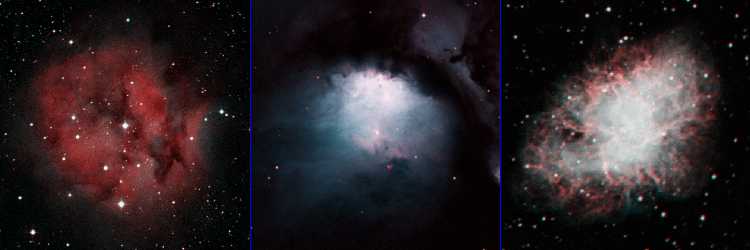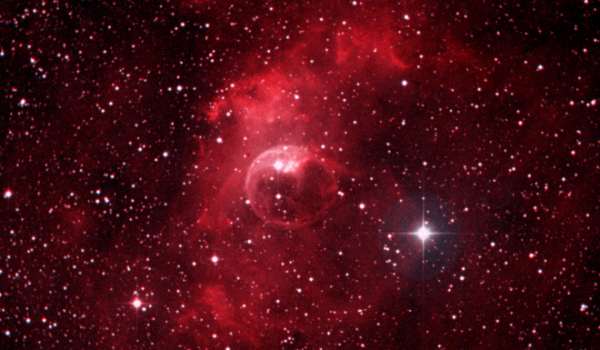
Bright nebulae are usually vast concentrations of gas and dust in which stars have been or are being formed. There are three main types of bright diffuse nebulae:

Below is a list of the brighter diffuse nebulae.
1 2 3 4 5 6 7 8 9 10 11
NGC Common Equatorial Galactic Nebula Size Distance Size Con
Number Name Coordinates Coordinates Type (arcmins) (ly) (ly)
RA (2000) Dec l° b°
7822 00 03.6 +68 37 118.6 +6.2 E 65'x20' 2800±400 50 Cep
281 00 52.8 +56 36 123.1 -6.3 E 30'x25' 8000±2000 70 Cas
IC59,IC63 Gamma Cas Nebula 00 56.7 +61 04 123.6 -1.8 RE 40'x10' 600±100 7 Cas
602 01 29.6 -73 33 299.2 -43.3 E 2'x1' 210000±10000 120 Hyi
IC1795,IC1805 Heart Nebula 02 33.4 +61 26 134.8 +0.9 E 100'x80' 6000±500 170 Cas
IC1848 Soul Nebula 02 51.3 +60 25 137.2 +0.9 E 105'x60' 6500±500 200 Cas
1333 03 29.3 +31 25 158.3 -20.4 R 9'x7' 1100±? 3 Per
1432,1435 Pleiades Nebula 03 47.0 +24 67 165.9 -22.8 R 180'x180' 400±25 20 Tau
1499 California Nebula 04 00.7 +36 37 160.1 -12.3 E 150'x40' 1500±500 70 Per
1491 04 02.9 +51 17 150.6 -1.0 E 3'x3' 10000±2000 9 Per
1554-55 Hind's Nebula (T Tau) 04 21.8 +19 32 176.2 -20.9 R 1'x1' 500±200 0.2 Tau
1579 04 30.7 +35 15 165.5 -8.9 R 8'x12' 2600±? 9 Per
1624 04 40.0 +50 27 155.3 +2.5 E 3'x3' 20000±5000 17 Per
IC2118 Witch Head Nebula 05 06.9 -07 13 207.3 -26.5 R 180'x60' 1000±500 50 Eri
IC405 Flaming Star Nebula 05 16.2 +34 16 172.1 -2.3 RE 30'x20' 1700±500 15 Aur
IC410 05 22.2 +33 23 173.6 -1.8 E 20'x20' 11000±2000 60 Aur
1931 05 31.4 +34 14 173.9 +0.3 RE 8'x8' 5900±1000 14 Aur
1952 Crab Nebula (M1) 05 34.5 +22 01 184.6 -5.8 S 6'x4' 7000±2000 12 Tau
-- Lambda Orionis (S264) 05 35.2 +09 56 195.0 -12.0 E 60'x60' 1400±300 25 Ori
1973,1975,1977 05 35.4 -04 50 208.5 -19.1 RE 40'x25' 1300±200 16 Ori
1976,1982 Orion Nebula (M42,M43) 05 35.4 -05 27 209.1 -19.4 E 60'x60' 1300±200 25 Ori
1999 05 36.3 -06 43 210.4 -19.7 R 2'x2' 1300±300 1 Ori
2070 Tarantula Nebula 05 38.7 -69 06 279.5 -31.7 E 40'x25' 170000±10000 2000 Dor
IC434 Horsehead Nebula 05 41.0 -02 24 206.9 -16.7 E 60'x10' 1300±300 25 Ori
2023-24 Flame Nebula 05 42.0 -01 50 206.5 -16.3 RE 30'x30' 1300±300 12 Ori
2068,2071 (M78) 05 46.7 +00 03 205.4 -14.3 R 30'x20' 1300±300 12 Ori
-- Barnard's Loop (S276) 05 55.0 -01 30 207.8 -13.2 E 840'x60' 1300±300 350 Ori
2149 06 03.5 -09 44 216.3 -15.0 E 3'x2' ? - Mon
2174 06 09.8 +20 19 190.2 +0.4 E 40'x30' 6000±1000 70 Ori
IC443 06 17.0 +22 29 189.1 +2.9 S 50'x40' 5000±1000 70 Gem
2237-38-39,2246 Rosette Nebula 06 32.3 +05 03 206.3 -1.9 E 80'x60' 4700±1000 110 Mon
2261 Hubble's Nebula (R Mon) 06 39.2 +08 44 203.8 +1.3 RE 2'x2' 3000±1500 2 Mon
2264 Cone Nebula (S Mon) 06 40.9 +09 54 202.9 +2.2 E 25'x15' 2200±500 16 Mon
2327,IC2177 Seagull Nebula 07 04.0 -11 18 224.4 -2.4 E 150'x50' 3800±500 170 CMa
2359 Thor's Helmet 07 17.6 -13 12 227.6 -0.3 E 10'x5' 20000±8000 60 CMa
2467 07 52.5 -26 24 243.2 +0.4 E 8'x7' 15000±3000 35 Pup
2736 Gum Nebula (part of) 09 00.4 -45 54 266.9 +0.2 S 10'x20' 1500±500 9 Vel
3199 10 17.1 -57 55 283.6 -1.0 E 22'x20' 15000±3000 90 Car
3372 Eta Carina Nebula 10 43.8 -59 52 287.5 -0.9 E 85'x80' 9000±1000 220 Car
3576,3581-82 11 12.1 -61 18 291.3 -0.7 E 30'x20' 6000±2000 50 Car
3603 11 15.1 -61 16 291.6 -0.5 E 20'x20' 20000±5000 120 Car
5367,IC4347 13 57.7 -39 59 316.5 +21.1 E 2'x1' 2100±500 1 Cen
IC4604 16 25.6 -23 26 353.7 +17.7 RE 60'x25' 600±200 10 Oph
6188 16 41.4 -48 05 337.2 -1.1 E 20'x12' 4400±1000 25 Ara
6334 Cat's Paw Nebula 17 20.3 -36 04 351.1 +0.6 E 40'x30' 5500±1000 60 Sco
6357 17 24.4 -34 09 353.2 +1.0 E 90'x60' 3300±800 90 Sco
6514 Trifid Nebula (M20) 18 02.6 -23 02 7.0 -0.3 RE 29'x27' 4000±1500 35 Sag
6523 Lagoon Nebula (M8) 18 03.8 -24 23 6.0 -1.2 E 80'x40' 4500±1000 100 Sag
6611,IC4703 Eagle Nebula (M16) 18 18.8 -13 47 17.0 +0.8 E 35'x30' 5700±1000 60 Ser
6618 Omega Nebula (M17) 18 20.8 -16 11 15.1 -0.8 E 40'x30' 4500±1000 50 Sag
IC1287 18 31.3 -10 50 21.0 -0.5 R 5'x4' 1000? 2 Scu
6726-27,6729 R CrA Nebula 19 01.5 -36 54 0.0 -17.8 RE 10'x10' 420±50 1 CrA
6820 19 42.5 +23 05 59.1 -0.1 E 20'x20' 6500±1000 40 Vul
6888 Crescent Nebula 20 12.0 +38 21 75.5 +2.4 E 20'x10' 4000±1000 25 Cyg
IC1318 Gamma Cyg Nebula 20 22.2 +40 15 78.1 +1.9 E 50'x50' 4000±1000 60 Cyg
6960 Veil Nebula West 20 45.6 +30 42 73.3 -7.6 S 70'x6' 2000±700 40 Cyg
IC5067-68,IC5070 Pelican Nebula 20 50.8 +44 21 84.6 +0.1 E 80'x70' 1900±500 40 Cyg
6992,6995 Veil Nebula East 20 56.4 +31 43 75.6 -8.8 S 80'x8' 2000±700 50 Cyg
7000 North America Nebula 20 58.8 +44 20 85.5 -1.0 E 120'x100' 1900±500 70 Cep
7023 21 01.8 +68 12 104.1 +14.2 R 18'x18' 1500±500 8 Cep
IC1396 21 39.0 +57 29 99.3 +3.7 E 170'x140' 2700±400 130 Cep
IC5146 Cocoon Nebula 21 53.5 +47 16 94.4 -5.5 RE 10'x10' 3200±500 9 Cyg
-- Cave Nebula (S155) 22 56.8 +62 37 110.2 +2.6 E 50'x30' 2400±500 35 Cep
7538 23 13.2 +61 29 111.5 +0.8 E 10'x7' 9000±3000 25 Cep
7635 Bubble Nebula 23 20.7 +61 12 112.2 +0.2 E 15'x8' 12000±3000 50 Cas
Column 1: NGC (or IC) catalog number of the nebula.
Column 2: Common name of the nebula.
Column 3: Right Ascension in hours and minutes for epoch 2000.
Column 4: Declination in degrees and minutes for epoch 2000.
Column 5: Galactic longitude of the nebula.
Column 6: Galactic latitude of the nebula.
Column 7: Nebula type, either Emission (E), Reflection (R) or Supernova remnant (S).
Column 8: Angular size of the nebula in arcminutes.
Column 9: Distance in light years to the nebula with the error.
Column 10: Diameter of the nebula in light years calculated using the distance and the angular size.
Column 11: Constellation in which the majority of the nebula lies.
References:
Clark R., (1990), Visual Astronomy of the Deep Sky, Cambridge University Press.
Blitz L., Fich M., Stark A., (1982), Catalog of CO Radial Velocities
toward Galactic H II Regions. Astrophys J Supp, 49, 183.
Caswell J.L., Haynes R.F., (1987) Southern HII Regions: an extensive study of radio
recombination line emission, Astron. Astrophys. 171, 261.
Cruz-Gonzalez C., Recillas-Cruz E., Costero R., Peimbert M., Torres-Peimbert S., (1974)
Catalogue of Galactic O Stars, Rev. Mex. Astron. Astrof. 1, 211.
Codella C., Felli M., Natale V., Palagi F., Palla F., (1994) The occurrence of H2O masers
in HII regions, Astron. Astrophys. 291, 261.
Guarinos J., (1992) Interstellar matter in the Galactic Disk, Catalogue of Extinctions
and Distances Derived from UBV data.
